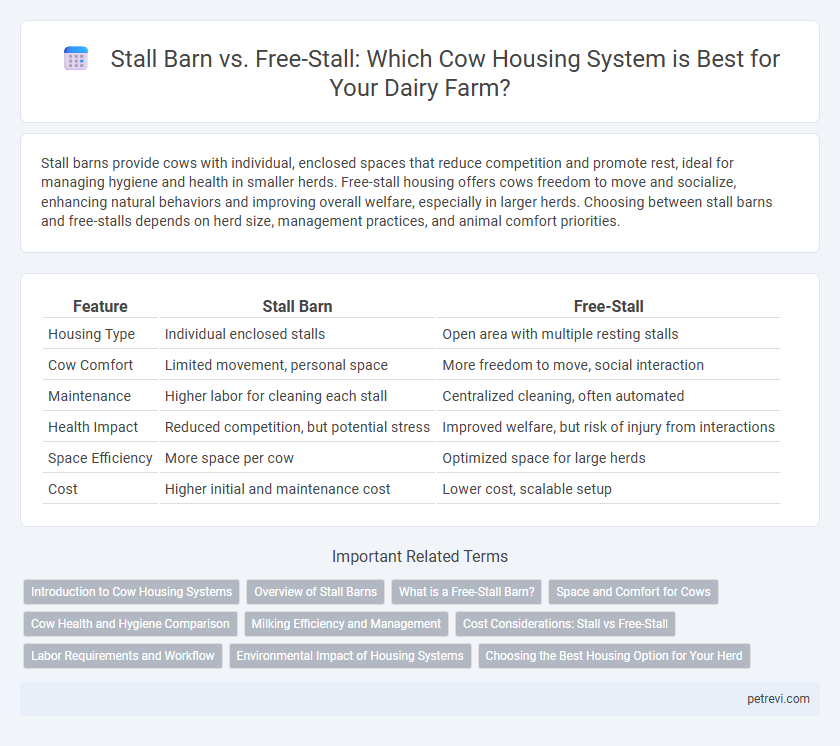Stall barns provide cows with individual, enclosed spaces that reduce competition and promote rest, ideal for managing hygiene and health in smaller herds. Free-stall housing offers cows freedom to move and socialize, enhancing natural behaviors and improving overall welfare, especially in larger herds. Choosing between stall barns and free-stalls depends on herd size, management practices, and animal comfort priorities.
Table of Comparison
| Feature | Stall Barn | Free-Stall |
|---|---|---|
| Housing Type | Individual enclosed stalls | Open area with multiple resting stalls |
| Cow Comfort | Limited movement, personal space | More freedom to move, social interaction |
| Maintenance | Higher labor for cleaning each stall | Centralized cleaning, often automated |
| Health Impact | Reduced competition, but potential stress | Improved welfare, but risk of injury from interactions |
| Space Efficiency | More space per cow | Optimized space for large herds |
| Cost | Higher initial and maintenance cost | Lower cost, scalable setup |
Introduction to Cow Housing Systems
Stall barns and free-stall systems represent two primary cow housing methods optimizing animal comfort and productivity. Stall barns provide individual stalls offering privacy and controlled resting areas, enhancing cow hygiene and reducing stress. Free-stall housing promotes natural movement and social interaction, balancing cow welfare with efficient space utilization and manure management.
Overview of Stall Barns
Stall barns provide individual, separated spaces for each cow, promoting better hygiene and reduced disease transmission compared to open housing. These barns often feature concrete floors and bedding materials such as sand or straw to enhance comfort and hoof health. Proper ventilation and lighting in stall barns contribute to improved cow welfare and productivity.
What is a Free-Stall Barn?
A free-stall barn is a type of cow housing designed to provide individual resting spaces called stalls, allowing cows to move freely between feeding, resting, and milking areas. Each stall typically features bedding materials like sand or straw to enhance comfort and hygiene, reducing the risk of injury and disease. This system optimizes cow welfare and productivity by promoting natural behaviors and minimizing stress compared to traditional tie-stall barns.
Space and Comfort for Cows
Free-stall barns provide individual resting spaces with bedding that enhances cow comfort and promotes better hygiene, while stall barns often limit movement due to fixed stalls. Free-stall designs typically allocate more space per cow, improving airflow and reducing stress, which supports higher milk production and overall health. Adequate space in free-stall housing reduces lameness and injury risks, offering a superior environment for cow welfare compared to traditional stall barns.
Cow Health and Hygiene Comparison
Stall barns provide individual cow housing that can reduce competition and injuries, promoting better hoof health and reducing mastitis risk through controlled bedding and cleanliness. Free-stall systems allow cows to move freely, improving natural behaviors and reducing stress-related illnesses, but require meticulous maintenance to prevent manure accumulation and associated hygiene issues. Both housing types impact cow health significantly, with stall barns excelling in hygiene control and free-stalls supporting welfare through mobility.
Milking Efficiency and Management
Free-stall barns enhance milking efficiency by providing cows with easy access to clean, comfortable resting areas, reducing stress and promoting consistent milking routines. Stall barns often require more labor for individual cow management, which can slow down milking processes and increase handling time. Optimized airflow and manure management in free-stall systems contribute to improved udder health, directly impacting milk yield and quality.
Cost Considerations: Stall vs Free-Stall
Stall barns typically require lower initial investment due to simpler construction and fewer materials, making them cost-effective for small-scale operations. Free-stall barns involve higher upfront costs driven by advanced ventilation, bedding systems, and space requirements, which can increase maintenance expenses but improve cow comfort and productivity. Evaluating long-term operational costs and potential milk yield benefits is essential when choosing between stall and free-stall housing systems.
Labor Requirements and Workflow
Free-stall housing systems for cows reduce labor requirements by streamlining feeding, cleaning, and manure management through automated equipment and designated resting areas. Stall barns often demand more manual labor for bedding replacement, stall cleaning, and individual cow care due to less mechanization. Workflow efficiency improves in free-stall setups by enabling continuous cow movement and minimizing time spent on maintenance tasks.
Environmental Impact of Housing Systems
Stall barns and free-stall housing systems differ significantly in their environmental impact, with free-stall systems often promoting better manure management and reduced greenhouse gas emissions. Proper ventilation and waste handling in free-stall barns help mitigate ammonia emissions and nutrient runoff, lowering risks of soil and water contamination. Stall barns may lead to higher concentrated waste areas, increasing the potential for environmental pollution without adequate treatment systems.
Choosing the Best Housing Option for Your Herd
Free-stall barns offer cows individual lying spaces with bedding and better ventilation, reducing the risk of mastitis and improving overall comfort. Stall barns, while simpler and lower cost, often limit movement and can increase stress and injury risk among the herd. Selecting the best housing depends on herd size, budget, and management goals, with free-stalls favored for maximizing health and productivity in larger operations.
Stall Barn vs Free-Stall for Cow Housing Infographic

 petrevi.com
petrevi.com